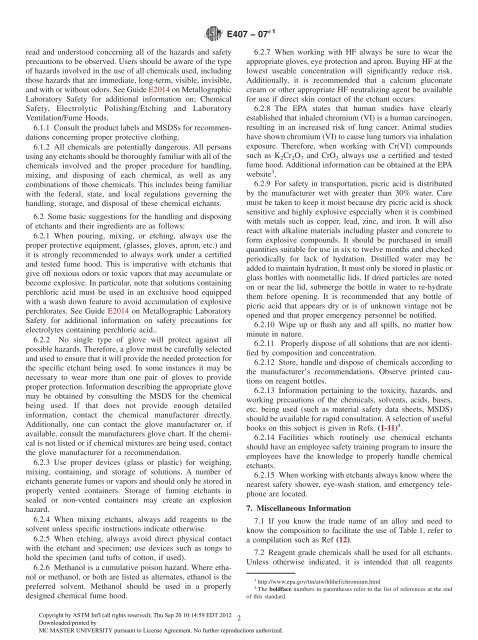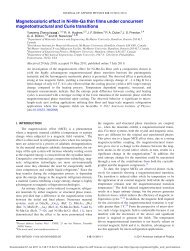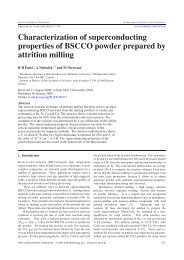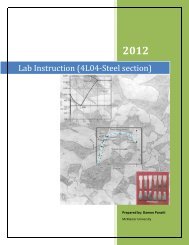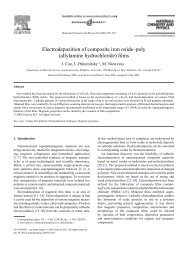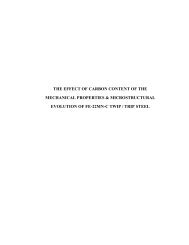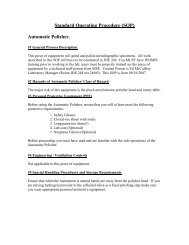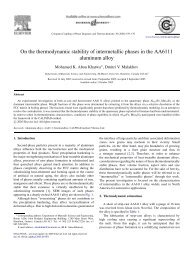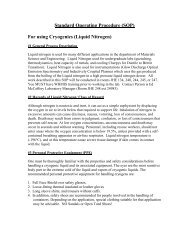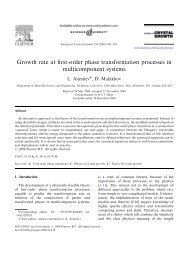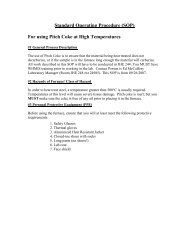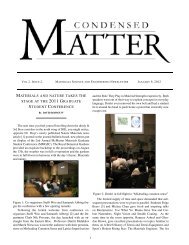E407-07 Microetching Metals and Alloys.pdf - McMaster Department ...
E407-07 Microetching Metals and Alloys.pdf - McMaster Department ...
E407-07 Microetching Metals and Alloys.pdf - McMaster Department ...
You also want an ePaper? Increase the reach of your titles
YUMPU automatically turns print PDFs into web optimized ePapers that Google loves.
ead <strong>and</strong> understood concerning all of the hazards <strong>and</strong> safety<br />
precautions to be observed. Users should be aware of the type<br />
of hazards involved in the use of all chemicals used, including<br />
those hazards that are immediate, long-term, visible, invisible,<br />
<strong>and</strong> with or without odors. See Guide E2014 on Metallographic<br />
Laboratory Safety for additional information on; Chemical<br />
Safety, Electrolytic Polishing/Etching <strong>and</strong> Laboratory<br />
Ventilation/Fume Hoods.<br />
6.1.1 Consult the product labels <strong>and</strong> MSDSs for recommendations<br />
concerning proper protective clothing.<br />
6.1.2 All chemicals are potentially dangerous. All persons<br />
using any etchants should be thoroughly familiar with all of the<br />
chemicals involved <strong>and</strong> the proper procedure for h<strong>and</strong>ling,<br />
mixing, <strong>and</strong> disposing of each chemical, as well as any<br />
combinations of those chemicals. This includes being familiar<br />
with the federal, state, <strong>and</strong> local regulations governing the<br />
h<strong>and</strong>ling, storage, <strong>and</strong> disposal of these chemical etchants.<br />
6.2 Some basic suggestions for the h<strong>and</strong>ling <strong>and</strong> disposing<br />
of etchants <strong>and</strong> their ingredients are as follows:<br />
6.2.1 When pouring, mixing, or etching, always use the<br />
proper protective equipment, (glasses, gloves, apron, etc.) <strong>and</strong><br />
it is strongly recommended to always work under a certified<br />
<strong>and</strong> tested fume hood. This is imperative with etchants that<br />
give off noxious odors or toxic vapors that may accumulate or<br />
become explosive. In particular, note that solutions containing<br />
perchloric acid must be used in an exclusive hood equipped<br />
with a wash down feature to avoid accumulation of explosive<br />
perchlorates. See Guide E2014 on Metallographic Laboratory<br />
Safety for additional information on safety precautions for<br />
electrolytes containing perchloric acid..<br />
6.2.2 No single type of glove will protect against all<br />
possible hazards. Therefore, a glove must be carefully selected<br />
<strong>and</strong> used to ensure that it will provide the needed protection for<br />
the specific etchant being used. In some instances it may be<br />
necessary to wear more than one pair of gloves to provide<br />
proper protection. Information describing the appropriate glove<br />
may be obtained by consulting the MSDS for the chemical<br />
being used. If that does not provide enough detailed<br />
information, contact the chemical manufacturer directly.<br />
Additionally, one can contact the glove manufacturer or, if<br />
available, consult the manufacturers glove chart. If the chemical<br />
is not listed or if chemical mixtures are being used, contact<br />
the glove manufacturer for a recommendation.<br />
6.2.3 Use proper devices (glass or plastic) for weighing,<br />
mixing, containing, <strong>and</strong> storage of solutions. A number of<br />
etchants generate fumes or vapors <strong>and</strong> should only be stored in<br />
properly vented containers. Storage of fuming etchants in<br />
sealed or non-vented containers may create an explosion<br />
hazard.<br />
6.2.4 When mixing etchants, always add reagents to the<br />
solvent unless specific instructions indicate otherwise.<br />
6.2.5 When etching, always avoid direct physical contact<br />
with the etchant <strong>and</strong> specimen; use devices such as tongs to<br />
hold the specimen (<strong>and</strong> tufts of cotton, if used).<br />
6.2.6 Methanol is a cumulative poison hazard. Where ethanol<br />
or methanol, or both are listed as alternates, ethanol is the<br />
preferred solvent. Methanol should be used in a properly<br />
designed chemical fume hood.<br />
<strong>E4<strong>07</strong></strong> − <strong>07</strong> ´1<br />
Copyright by ASTM Int'l (all rights reserved); Thu Sep 20 10:14:59 EDT 2012<br />
2<br />
Downloaded/printed by<br />
MC MASTER UNIVERSITY pursuant to License Agreement. No further reproductions authorized.<br />
6.2.7 When working with HF always be sure to wear the<br />
appropriate gloves, eye protection <strong>and</strong> apron. Buying HF at the<br />
lowest useable concentration will significantly reduce risk.<br />
Additionally, it is recommended that a calcium gluconate<br />
cream or other appropriate HF neutralizing agent be available<br />
for use if direct skin contact of the etchant occurs.<br />
6.2.8 The EPA states that human studies have clearly<br />
established that inhaled chromium (VI) is a human carcinogen,<br />
resulting in an increased risk of lung cancer. Animal studies<br />
have shown chromium (VI) to cause lung tumors via inhalation<br />
exposure. Therefore, when working with Cr(VI) compounds<br />
such as K2Cr2O7 <strong>and</strong> CrO3 always use a certified <strong>and</strong> tested<br />
fume hood. Additional information can be obtained at the EPA<br />
website 3 .<br />
6.2.9 For safety in transportation, picric acid is distributed<br />
by the manufacturer wet with greater than 30% water. Care<br />
must be taken to keep it moist because dry picric acid is shock<br />
sensitive <strong>and</strong> highly explosive especially when it is combined<br />
with metals such as copper, lead, zinc, <strong>and</strong> iron. It will also<br />
react with alkaline materials including plaster <strong>and</strong> concrete to<br />
form explosive compounds. It should be purchased in small<br />
quantities suitable for use in six to twelve months <strong>and</strong> checked<br />
periodically for lack of hydration. Distilled water may be<br />
added to maintain hydration, It must only be stored in plastic or<br />
glass bottles with nonmetallic lids. If dried particles are noted<br />
on or near the lid, submerge the bottle in water to re-hydrate<br />
them before opening. It is recommended that any bottle of<br />
picric acid that appears dry or is of unknown vintage not be<br />
opened <strong>and</strong> that proper emergency personnel be notified.<br />
6.2.10 Wipe up or flush any <strong>and</strong> all spills, no matter how<br />
minute in nature.<br />
6.2.11 Properly dispose of all solutions that are not identified<br />
by composition <strong>and</strong> concentration.<br />
6.2.12 Store, h<strong>and</strong>le <strong>and</strong> dispose of chemicals according to<br />
the manufacturer’s recommendations. Observe printed cautions<br />
on reagent bottles.<br />
6.2.13 Information pertaining to the toxicity, hazards, <strong>and</strong><br />
working precautions of the chemicals, solvents, acids, bases,<br />
etc. being used (such as material safety data sheets, MSDS)<br />
should be available for rapid consultation. A selection of useful<br />
books on this subject is given in Refs. (1-11) 4 .<br />
6.2.14 Facilities which routinely use chemical etchants<br />
should have an employee safety training program to insure the<br />
employees have the knowledge to properly h<strong>and</strong>le chemical<br />
etchants.<br />
6.2.15 When working with etchants always know where the<br />
nearest safety shower, eye-wash station, <strong>and</strong> emergency telephone<br />
are located.<br />
7. Miscellaneous Information<br />
7.1 If you know the trade name of an alloy <strong>and</strong> need to<br />
know the composition to facilitate the use of Table 1, refer to<br />
a compilation such as Ref (12).<br />
7.2 Reagent grade chemicals shall be used for all etchants.<br />
Unless otherwise indicated, it is intended that all reagents<br />
3 http://www.epa.gov/ttn/atw/hlthef/chromium.html<br />
4 The boldface numbers in parentheses refer to the list of references at the end<br />
of this st<strong>and</strong>ard.


